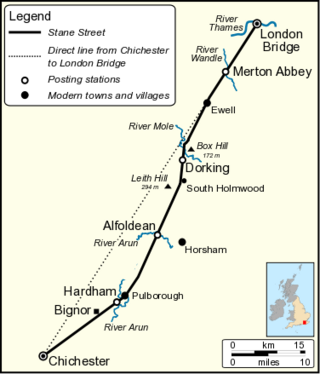
Surrey Archaeological Society is a county archaeological society, founded in 1854 for "the investigation of subjects connected with the history and antiquities of the County of Surrey" in England.

Surrey Archaeological Society is a county archaeological society, founded in 1854 for "the investigation of subjects connected with the history and antiquities of the County of Surrey" in England.
The Society concerns itself with "the County of Surrey within the boundaries existing in 1854 … and as may be enlarged by any extension of the present Administrative County". Its geographical interests therefore cover, in addition to the modern administrative county of Surrey, the areas now forming the London boroughs of Lambeth, Wandsworth, Southwark, Croydon, Kingston, Merton, Sutton, and Richmond; as well as the district of Spelthorne, which became part of the county only in 1965. Where appropriate, however, the Society works in close cooperation with other archaeological agencies, such as Museum of London Archaeology.
The Society's headquarters, which include an extensive library, are located at Castle Arch, Guildford. The building also houses Guildford Museum, itself originally established by the Society, although now quite independent. The Society incorporates nine Special Interest Groups: the Artefacts and Archives Recording Group; the Local History Group; the Medieval Studies Forum; the Prehistoric Group; the Roman Studies Group; the Surrey Industrial History Group; the Villages Study Group; the Guildford Archaeology and Local History Group; and the Research Committee.

The Society's official journal is Surrey Archaeological Collections, first published in 1858, and which now appears annually.
Since 1973, the journal has been supplemented by Surrey History, a more popular historical magazine. The Society also issues a regular bimonthly Bulletin, containing news, short reports and articles, and notices of forthcoming events.
The Society has also published a number of occasional single issue publications, notably in its Research Volumes, Research Papers and Village Studies series. It has published two larger multi-authored volumes providing a broader overview of the county's archaeology and history:
The Surrey Industrial History Group publishes its own Newsletter, and other occasional publications.
In 1894 the Society published a calendar of medieval Surrey feet of fines, edited by Frank Lewis, as "Surrey Archaeological Collections, Extra Volume 1". In the event this was the only "extra volume" ever published. In 1912, the honorary secretary, Hilary Jenkinson (himself an archivist), finding a lack of enthusiasm within the society for further sustained record publication, established the Surrey Record Society as an independent body, and the two societies have coexisted amicably ever since.

Guildford is a town in west Surrey, England, around 27 mi (43 km) south-west of central London. As of the 2011 census, the town has a population of about 77,000 and is the seat of the wider Borough of Guildford, which had around 145,673 inhabitants in mid-2022 est. The name "Guildford" is thought to derive from a crossing of the River Wey, a tributary of the River Thames that flows through the town centre.

Farley Green is a small hamlet of Albury in the Greensand Ridge where it forms the south of the Surrey Hills AONB, to the south east of Guildford.

Stane Street is the modern name of the 91 km-long (57 mi) Roman road in southern England that linked Londinium (London) to Noviomagus Reginorum (Chichester). The exact date of construction is uncertain; however, on the basis of archaeological artefacts discovered along the route, it was in use by 70 AD and may have been built in the first decade of the Roman occupation of Britain.

Westcott is a village in central Surrey, England, about 1.5 miles (2.5 km) west of the centre of Dorking. It is in the Mole Valley district and the Surrey Hills Area of Outstanding Natural Beauty. The Pipp Brook, a tributary of the River Mole, runs to the north of the centre and the settlement is between Ranmore Common on the North Downs and Leith Hill on the Greensand Ridge.

Guildford Museum is the main museum in the town of Guildford, Surrey, England. The museum is on Quarry Street, a narrow road lined by pre-1900 cottages running just off the pedestrianised High Street. This main site of the museum forms the gatehouse and annex of Guildford Castle, which the staff help to run. It is run by Guildford Borough Council and has free entry between 11am and 4:45pm on Monday to Saturday. It is closed on Sundays and on Christmas Day.

A text publication society is a learned society which publishes scholarly editions of old works of historical or literary interest, or archival documents. In addition to full texts, a text publication society may publish translations, calendars, and indexes.
Louis Francis Salzman was a British economic historian who specialised in the medieval period.
Sussex Archaeological Collections is an annual peer-reviewed academic journal covering archaeological topics. The journal is published by the Sussex Archaeological Society and was established in 1848.

Rupert Leo Scott Bruce-Mitford was a British archaeologist and scholar. He spent the majority of his career at the British Museum, primarily as the Keeper of the Department of British and Medieval Antiquities, and was particularly known for his work on the Sutton Hoo ship-burial. Considered the "spiritus rector" of such research, he oversaw the production of the monumental three-volume work The Sutton Hoo Ship-Burial, termed by the president of the Society of Antiquaries as "one of the great books of the century".
The Yorkshire Archaeological and Historical Society (YAHS), formerly known as the Yorkshire Archaeological Society, is a learned society and registered charity founded in 1863. It is dedicated to the study of the archaeology, history and people of the three Ridings of the historic county of Yorkshire. It publishes an annual journal, the Yorkshire Archaeological Journal; and, particularly through its Record Series, it also functions as a text publication society. Its headquarters are in Leeds.

The Cambrian Archaeological Association was founded in 1846 to examine, preserve and illustrate the ancient monuments and remains of the history, language, manners, customs, arts and industries of Wales and the Welsh Marches and to educate the public in such matters. The association's activities include sponsoring lectures, field visits, and study tours; as well as publishing its journal, Archaeologia Cambrensis, and monographs. It also provides grants to support research and publications.

The British Records Association is a British learned society founded in 1932 to promote the preservation, understanding, accessibility and study of historic records and archives. It is a registered charity. It issues a journal, Archives, and other publications; hosts conferences and seminars; and undertakes other activities to promote the care and preservation of archives and the interests of archive users at a national level. Membership is open to all, and the association therefore plays a particular role as a forum which brings together owners of archives, academic and amateur documentary researchers, archivists and librarians, and institutions and societies concerned with archives.

Sir Charles Hilary Jenkinson was a British archivist and archival theorist, regarded as the figure most responsible for bringing continental European concepts of archival theory to the English-speaking world.
Surrey Record Society is a text publication society which edits and publishes historic records relating to the county of Surrey, England. The society concerns itself with the historic county, which includes, in addition to the current administrative county, the areas now forming the London boroughs of Lambeth, Wandsworth, Southwark, Croydon, Kingston, Merton, Sutton, and Richmond. The Society has also published two editions of registers of medieval bishops of Winchester, Surrey having historically formed part of the Diocese of Winchester.
Margerie Venables Taylor, was an archaeologist and editor of the Journal of Roman Studies, and held posts including Secretary for the Society for the Promotion of Roman Studies. She was particularly instrumental in recording excavations in Roman Britain.

The London and Middlesex Archaeological Society (LAMAS) is a society founded in 1855 for the study of the archaeology and local history of the City of London and the historic county of Middlesex. It also takes an interest in districts that were historically in Surrey, Kent, Essex and Hertfordshire, but that now lie within Greater London. The Society receives support from the Museum of London, and works in close association both with the Museum and with Museum of London Archaeology. It acts to some extent as an umbrella organisation to support smaller archaeological and local history societies in the Greater London area. It hosts an Annual Conference of London Archaeologists and an annual Local History Conference.
Dominic Tweddle,, is an English archaeologist specialising in Anglo-Saxon studies and the director general of the National Museum of the Royal Navy. Previously he spent time as a research assistant at the British Museum and as the assistant director of the York Archaeological Trust, where he helped develop the Jorvik Viking Centre. He is also an honorary professor at the UCL Institute of Archaeology and the University of Portsmouth.

Marion MacCallum Archibald was a British numismatist, author and for 33-years a curator at the British Museum. She was the first woman to be appointed Assistant Keeper in the Department of Coins and Medals and is regarded as a pioneer in what had previously been a male-dominated field. Her 70th birthday was celebrated with the publication of a book of essays authored by 30 of her colleagues, collaborators and former students for whom Marion's name was "synonymous ... with the study of Anglo-Saxon coins at the British Museum".

Hilda Elizabeth Jean Le Patourel was a British archaeologist. She specialised in the ceramics and pottery of Yorkshire. She later expanded her field of research to include moated sites and the archaeological remains of dog collars.
The Worcestershire Archaeological Society, founded in 1854, is a local historical, antiquarian, and archaeological society and registered charity covering Worcestershire.
{{cite web}}: Missing or empty |url= (help)